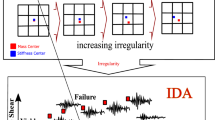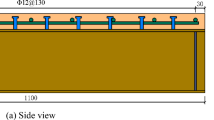Abstract
This study investigates the construction of Pressure-Impulse (P-I) diagrams, a crucial tool in the protective design of structures exposed to blast loads. Prior research has employed diverse methods, such as equivalent single-degree-of-freedom (SDOF) systems and finite element (FE) models, for developing P-I diagrams. However, concerns persist regarding their reliability under impulsive and dynamic loading conditions due to inherent simplifications in modeling material and structural behaviors, limited ability to capture shear deformations, and constraints associated with the chosen damage criteria. To address these concerns comprehensively, this study utilizes a three-dimensional (3-D) FE model with enhanced damage criteria to generate P-I diagrams for fixed-end reinforced concrete (RC) beams exposed to blast loads. A comparison is made between loosely coupled SDOF systems and 3-D FE models, with both approaches employing the proposed damage criteria to assess the accuracy of P-I diagrams. Accordingly, the fixed-end RC beam is represented through two distinct modeling approaches: an equivalent loosely coupled SDOF system created with MATLAB and a 3-D FE model developed using ABAQUS. The developed models are subjected to various blast scenarios representing the far-field, near-field, and close-in blast and identified the failure as flexure, flexure-shear, or direct shear based on the proposed damage criteria. Results reveal that P-I diagrams relying solely on flexure-based damage criteria lack reliability, particularly under impulsive and dynamic loading, where direct shear and flexure-shear failures prevail. Similarly, employing flexure and direct shear-based damage criteria alone yields unreliable P-I diagrams, often missing the possibility of combined flexure-shear failure. In contrast, P-I diagrams from loosely coupled SDOF and FE models with proposed damage criteria effectively represent all potential failure modes. However, the loosely coupled SDOF systems overpredict the safe zone, resulting in inaccurate P-I diagrams. Thus, FE analysis with the proposed damage criteria is recommended for precise P-I diagrams in blast-loaded structural design.



















Similar content being viewed by others
References
Baker WE, Cox PA, Westine PS, Kulesz JJ, Strehlow RA (1983) Explosion hazards and evaluation. Elsevier
Cormie D, Mays C, Smith P (2009) Blast effects on buildings (2nd ed). Thomas Telford Ltd
Sperrazza J (1951) Dependence of external blast damage to the A-25 Aircraft on peak pressure and impulse (575). Maryland, USA
Thiagarajan G, Rahimzadeh R, Kundu A (2013) Study of Pressure impulse diagrams for reinforced concrete columns using Finite Element Analysis. Int J Protective Struct 4:485–504
Shi Y, Hao H, Li Z-X (2008) Numerical derivation of pressure–impulse diagrams for prediction of RC column damage to blast loads. Int J Impact Eng 35(11):1213–1227
Ding Y, Wang M, Li Z-X, Hao H (2013) Damage evaluation of the steel tubular column subjected to explosion and post-explosion fire condition. Eng Struct 55:44–55
IS 4991 (1968) Criteria for blast resistant design of structures for explosion above ground. Indian Standards
TM 5–1300 (1990) Structures to resist the effects of accidental explosions. Technical Manual, US Army Corps of Engineers
Department of Defense, UFC 3–340–02 (2008) Structures to Resist the Effects of the Accidental Explosions. Technical Report, Unified Facilities Criteria
ASCE/SEI 59–11 (2011) Blast protection of buildings. American Society of Civil Engineers/Structural Engineering Institute
FEMA 426 (2011) Reference manual to mitigate potential terrorist attacks against buildings. Federal Emergency Management Agency
Dragos J, Wu C (2014) Interaction between direct shear and flexural responses for blast loaded one-way reinforced concrete slabs using a finite element model. Eng Struct 72:193–202
Shi HJ, Salim H, Ma G (2012) Using P-I diagram method to assess the failure modes of rigid plastic beams subjected to triangular impulsive loads. Int J Protective Struct 3(3):333–353
Wang W, Zhang D, Lu F, Wang SC, Tang F (2012) The effect of span length to height ratio of reinforced concrete slabs on pressure-impulse diagram with multiple failure modes under blast loading. In EPJ Web of Conferences 26:04015
Li J, Hao H (2013) Influence of brittle shear damage on accuracy of the two-step method in prediction of structural response to blast loads. Int J Impact Eng 54:217–231
Mutalib AA, Hao H (2011) Development of P-I diagrams for FRP strengthened RC columns. Int J Impact Eng 38(5):290–304
Baker WE, Cox PA, Westine PS, Kulesz JJ, Strehlow RA (1978) A short course on explosion hazards evaluation. Southwest Research Institute
Zhu G, Huang YG, Yu TX, Wang R (1986) Estimation of the plastic structural response under impact. Int J Impact Eng 4(4):271–282
Chernin L, Vilnay M, Shufrin I, Cotsovos E (2019) Pressure-impulse diagram method: a fundamental Review. Proc Inst Civil Eng Eng Comput Mech 172(2):55
Fallah AS, Louca LA (2007) Pressure–impulse diagrams for elastic-plastic-hardening and softening single-degree-of freedom models subjected to blast loading. Int J Impact Eng 34(4):823–842
Dragos J, Wu C, Vugts K (2013) Pressure-Impulse Diagrams for an Elastic-Plastic Member under Confined Blasts. Int J Protective Struct 4(2):143–162
Razaqpur G, Mekky W, Foo S (2009) Fundamental concepts in blast resistance evaluation of structures. Can J Civ Eng 36(8):1292–1304
Thiagarajan G, Kadambi AV, Robert S, Johnson CF (2015) Experimental and finite element analysis of doubly reinforced concrete slabs subjected to blast loads. Int J Impact Eng 75:162–173
Hooper PA, Sukhram RAM, Blackman BRK, Dear JP (2012) On the blast resistance of laminated glass. Int J Solids Struct 49(6):899–918
Parlin NJ, Davids WG, Nagy E, Cummins T (2014) Dynamic response of lightweight wood-based flexible wall panels to blast and impulse loading. Constr Build Mater 50:237–245
Liu L, Zong ZH, Tang B, Li MH (2018) Damage Assessment of an RC Pier under Noncontact Blast Loading Based on P-I Curves. Shock Vib. https://doi.org/10.1155/2018/9204036
Krauthammer T, Bazeos N, Holmquist TJ (1986) Modified SDOF analysis of RC box-type structures. J Struct Eng 112(4):726–744
Krauthammer T, Astarlioglu S, Blasko J, Soh TB, Ng PH (2008) Pressure-impulse diagrams for the behavior assessment of structural components. Int J Impact Eng 35:771–783
Wang W, Zhang D, Lu F, Tang F, Wang SC (2013) Pressure-impulse diagram with multiple failure modes of one-way reinforced concrete slab under blast loading using SDOF method. J Cent South Univ 20:510–519
Yu RQ, Zhang DD, Chen L, Yan HC (2018) Non-dimensional pressure-impulse diagrams for blast loaded reinforced concrete beam columns referred to different failure modes. Adv Struct Eng 21(14):2114–2129
Yu R, Chen L, Fang Q, Yan H, Chen G (2019) Generation of pressure-impulse diagrams for failure modes of RC columns subjected to blast loads. Eng Fail Anal 100:520–535
Bhatt A, Bhargava P (2023) Pressure-impulse diagrams using coupled single degree of freedom systems subjected to blast load. Asian Journal of Civil Engineering, 1–13
Ju SJ, Kwak HG (2022) A FE model to evaluate the resisting capacity of RC beams and columns under blast loading based on P-I diagram. Int J Impact Eng 161:104113
Astarlioglu S, Krauthammer T (2014) Response of normal-strength and ultra-high-performance fiber-reinforced concrete columns to idealized blast loads. Eng Struct 61:1–12
Syed ZI, Mohamed OA, Rahman SA (2016) Nonlinear finite element analysis of offshore stainless steel blast wall under high impulsive pressure loads. Procedia Eng 145:1275–1282
Sammarco E, Williamson E (2021) Dynamic Response Characteristics that Lead to Direct Shear Failure in Blast-Loaded Columns. J Struct Eng 147(9):1–17
The MathWorks Inc. (2022) MATLAB version: 9.13.0 (R2022b), Natick, Massachusetts
ABAQUS (2017) Theory Manual. Dassault Systemes Simulia Corporation, Providence, RI, USA
Biggs JM (1964) Introduction to structural dynamics. McGraw-Hill Book Company
Krauthammer T, Shahriar S, Shanaa HM (1990) Response of reinforced concrete elements to severe impulsive loads. J Struct Eng 116(4):1061–1079
Hawkins N (1981) Dynamic shear resistance of reinforced concrete. Letter Report U.S. Navy
Krauthammer T, Assadi-lamouki A, Shanaa HM (1993) Analysis of impulsive loaded reinforced concrete structural elements. II: Implementation. Comput Struct 48(5):861–871
Kingery CN, Bulmash G (1984) Air blast parameters from TNT spherical air burst and hemispherical surface burst. Army BRL Report ARBRL-TR-02555
Astarlioglu S, Krauthammer T, Morency D, Tran TP (2013) Behavior of reinforced concrete columns under combined effects of axial and blast-induced transverse loads. Eng Struct 55:26–34
Ma LL, Wu H, Fang Q (2023) A unified performance-based blast-resistant design approach for RC beams/columns. Int J Impact Eng 173:104459
Comite Euro-International du Beton (2010) CEB-FIP Model code for concrete structures. Thomas Telford
Zhou XQ, Hao H (2008) Modelling of compressive behavior of concrete-like materials at high strain rate. Int J Solids Struct 45(17):4648–4661
Comite Euro-International du Beton (1988) Concrete Structures under Impact and Impulsive Loading: Synthesis Report. CEB Bulletin 187
Lubliner J, Oliver J, Oller S, Oñate E (1989) A plastic-damage model for concrete. Int J Solids Struct 25:299–326
Jeeho L, Gregory LF (1998) Plastic-damage model for cyclic loading of concrete structures. J Eng Mech 124:892–900
Saenz LP (1964) Discussion of equation for the stress-strain curve of concrete. ACI J 61:1227–1239
Sinha BP, Gerstle KH, Tulin LG (1964) Stress-strain relations for concrete under cyclic loading. ACI J Proc 61(2):195–212
Hordijk DA (1992) Tensile and tensile fatigue behaviour of concrete – experiments, modeling and analyses. Heron 37(1):3–79
Reinhardt HW, Cornelissen HAW (1984) Post-peak cyclic behaviour of concrete in uniaxial tensile and alternating tensile and compressive loading. Cem Concr Res 14:263–270
Gozzi J (2004) Plastic behaviour of steel: Experimental investigation and modelling. Licentiate Thesis, Lulea University of Technology, Sweden
Zhang D, Yao SJ, Lu F, Chen XG, Lin G, Wang W (2013) Experimental study on scaling of RC beams under close-in blast loading. Eng Fail Anal 33:497–504
Wu C, Oehlers DJ, Rebentrost M, Leach J, Whittaker AS (2009) Blast testing of ultra-high performance fibre and FRP-retrofitted concrete slabs. Eng Struct 31(9):2060–2069
Funding
The authors declare that no funds, grants, or other support were received during the preparation of this manuscript.
Author information
Authors and Affiliations
Contributions
The conceptualization, visualization, methodology, software, investigation, and original draft preparation was by Ravi Mudragada and the supervision, review and editing was by Pradeep Bhargava. All authors reviewed the manuscript.
Corresponding author
Ethics declarations
Competing interests
The authors declare no competing interests.
Additional information
Publisher's Note
Springer Nature remains neutral with regard to jurisdictional claims in published maps and institutional affiliations.
Rights and permissions
Springer Nature or its licensor (e.g. a society or other partner) holds exclusive rights to this article under a publishing agreement with the author(s) or other rightsholder(s); author self-archiving of the accepted manuscript version of this article is solely governed by the terms of such publishing agreement and applicable law.
About this article
Cite this article
Mudragada, R., Bhargava, P. Derivation of pressure-impulse diagrams for blast-loaded RC members. J Build Rehabil 9, 64 (2024). https://doi.org/10.1007/s41024-024-00411-9
Received:
Revised:
Accepted:
Published:
DOI: https://doi.org/10.1007/s41024-024-00411-9




